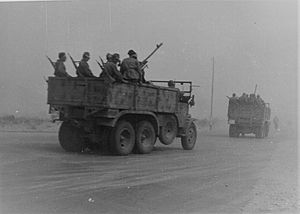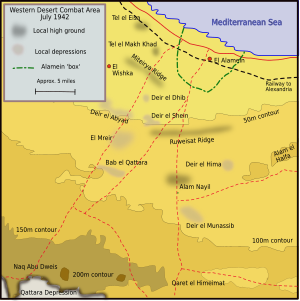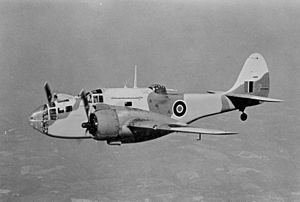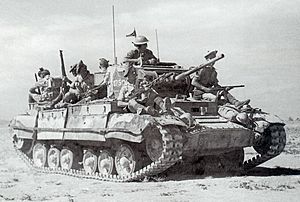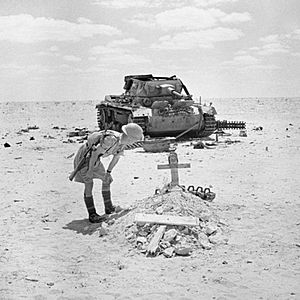Battle of Alam el Halfa facts for kids
Quick facts for kids Battle of Alam el Halfa |
|||||||
|---|---|---|---|---|---|---|---|
| Part of the Western Desert Campaign of the Second World War | |||||||
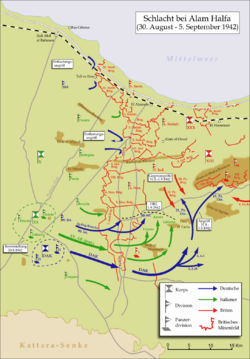 Map of the battlefield (in German) |
|||||||
|
|||||||
| Belligerents | |||||||
| Commanders and leaders | |||||||
| Strength | |||||||
| XIII Corps (Eighth Army): 4 divisions |
Panzer Army Africa: 6 divisions |
||||||
| Casualties and losses | |||||||
| 1,750 killed, wounded or captured 68 tanks 67 aircraft |
2,900 killed, wounded or captured 49 tanks 36 aircraft 60 guns 400 transport vehicles |
||||||
The Battle of Alam el Halfa was a major fight during World War II. It happened near El Alamein, Egypt, from August 30 to September 5, 1942. This battle was part of the Western Desert Campaign.
The German and Italian forces, called Panzerarmee Afrika, were led by Erwin Rommel. They tried to surround the British Eighth Army. The British army was commanded by Bernard Montgomery. Rommel hoped to defeat the British before more Allied troops arrived.
Montgomery knew about Rommel's plans because of secret messages called Ultra. He left a gap in his defenses in the south. This was where Rommel planned to attack. Montgomery then placed most of his tanks and cannons on Alam el Halfa Ridge. This ridge was about 20 kilometers behind the front lines.
Unlike earlier battles, Montgomery told his tanks to stay put. They acted like strong anti-tank guns on the ridge. Rommel's attacks on the ridge failed. His forces also ran low on supplies. So, Rommel ordered his troops to pull back. The 2nd New Zealand Division tried an attack called Operation Beresford. It was against Italian positions but it failed and cost many lives.
Montgomery did not chase Rommel's retreating army. He wanted to build up his strength for a bigger attack later. This later attack became the Second Battle of El Alamein. Rommel thought British air power caused his defeat. He did not know about the secret Ultra messages. After Alam el Halfa, the Axis forces in Africa lost their chance to win the war there.
Contents
Why the Battle Happened
After the First Battle of El Alamein in July 1942, things were quiet for a bit. The Axis forces, led by Rommel, had problems getting supplies. Their main supply ports were very far from the front lines. For example, Tobruk was 400 kilometers away.
The original plan for the Axis was to capture Tobruk. Then they would pause to prepare for invading Egypt. But their big win at Gazala made Rommel chase the British. He wanted to stop them from setting up new defenses.
Meanwhile, the British on Malta got stronger. They started attacking Axis supply ships more often. By late August, the Axis forces had new troops. But they were very short on fuel and ammunition. Rommel's German tank numbers had grown to 234. Italian tanks also increased to 281. But without fuel, these tanks were useless.
The British, on the other hand, were getting more supplies. New Sherman tanks and better anti-tank guns arrived. The British air force also had a big advantage in the sky. British intelligence was also much better. They were getting useful information.
German spies told Rommel that a huge Allied convoy was coming. It would bring many new vehicles for the British. Rommel knew this would make the British much stronger. He asked Italy for 6,000 tons of fuel. But by August 29, over half of the supply ships were sunk. Only 1,500 tons of fuel reached him. Rommel had to attack quickly. He hoped for a fast victory before the British became too powerful.
Planning the Attack
At El Alamein, the land was tricky. An attack had to go between the coast and the Qattara Depression. This depression was about 40 kilometers south and tanks could not cross it. The British defenses were strong in the north. Rommel thought the southern part was weaker. He believed it had fewer mines.
Rommel planned a night attack. He wanted his forces to be past the British minefields by sunrise. The main attack would be by two German tank divisions. These were the 15th Panzer Division and the 21st Panzer Division. They would break through the minefields in the south. Then they would turn north. Rommel hoped to surround and destroy the British Eighth Army. This would open the way to the Suez Canal.
British Defenses
British secret messages (Ultra) had warned them about an Axis attack. On August 13, Bernard Montgomery took command of the Eighth Army. He decided to hold the ground around Alamein at all costs.
In the northern part, the British XXX Corps was ready. It had Australian, South African, and Indian divisions. They were behind minefields.
The XIII Corps held the south. The 2nd New Zealand Division was there. Montgomery chose to defend the southern area lightly. This was to trick Rommel into attacking there. This gap would have mines and wires. British light armored units would cover the minefields. They would pull back when needed.
The main British defenses were on the Alam el Halfa ridge. This was behind the front line. Most of the British tanks and anti-tank guns were dug in. They waited for the Axis attack. The 10th Armoured Division was also getting ready. It had new Grant tanks with powerful 75mm guns. These tanks would reinforce the Alam el Halfa position.
The Battle Begins
August 30-31
The attack started on the night of August 30. There was a full moon. But things went wrong for Rommel right away. The British air force spotted the Axis troops. They launched many air attacks. British planes dropped flares to light up targets for bombers and artillery.
The minefields were much deeper than Rommel thought. The British units covering the minefields fought hard. They caused many Axis casualties before pulling back. General Walther Nehring, a German commander, was hurt in an air raid. General Georg von Bismarck, another German commander, was killed by a mine.
August 31
Despite these problems, Rommel's forces got through the minefields by midday. They turned left and were ready for the main attack. But they were late. The British 7th Armoured Division kept attacking their sides. This forced the Axis tanks to turn north earlier than planned. They headed straight for the strong British defenses on Alam el Halfa.
At 1:00 PM, the 15th Panzer Division attacked. The 21st Panzer followed an hour later. The British 22nd Armoured Brigade held the ridge. They had 92 Grant tanks and 74 light tanks. Anti-tank guns and artillery supported them.
The German tanks included 74 up-armored Panzer IIIs and 27 Panzer IVs. The British had about 700 tanks at the front. About 160 of these were Grants. As the German tanks got closer, their Panzer IVs fired from far away. They destroyed several British tanks. The British Grant tanks had a problem. Their main gun was in the hull. This meant they could not fire from a hidden position.
When the Germans came closer, they faced heavy fire from the British. An attempt to go around the British was stopped by anti-tank guns. Night was falling, and fuel was running low. The German commander ordered the tanks to pull back. In this fight, the Germans lost 22 tanks, and the British lost 21.
There was also tough fighting on the ground. Italian and German infantry attacked Indian, South African, and New Zealand units. They captured one point but were later pushed back.
September 1-2
The night of August 31 to September 1 was hard for the Axis. British bombers kept attacking their supply lines. This made Rommel's fuel problems even worse. Over half of the fuel promised to him was sunk. On September 1, the 21st Panzer Division did not move. This was likely due to lack of fuel.
The 15th Panzer Division attacked the British 22nd Armoured Brigade. But a flank attack by the 8th Armoured Brigade stopped them. The Germans did not lose many tanks. But they could not advance. Air raids continued all day and night. By the morning of September 2, Rommel knew his attack had failed. He decided to pull back.
Axis Retreat
Rommel told his commanders that he had to retreat. He blamed the lack of fuel, British air power, and the loss of surprise. On September 2, British armored cars attacked 300 Axis supply trucks. They destroyed 57 of them. Italian armored units had to move to protect the supply lines.
The British air force flew many missions. Montgomery realized the German tanks were about to retreat. He planned attacks by the 7th Armoured Division and the 2nd New Zealand Division. He told them to avoid heavy losses. The 7th Armoured Division managed to harass the enemy. But the New Zealand Division's attack was more difficult.
September 3-4: Operation Beresford
Operation Beresford started at 10:30 PM on September 3. The New Zealanders on the left caused many casualties to the Italian defenders. They also defeated Axis counter-attacks the next morning. But the attack by the 132nd Infantry Brigade was a costly failure. Their Valentine tanks got lost in the dark. Twelve tanks were destroyed by mines. The Germans caused many casualties to the British and New Zealanders. A British commander was wounded. Another New Zealand commander was captured.
The strong Axis defense showed that another attack would likely fail. So, the British troops were pulled back on the night of September 4.
September 5
By September 5, the Axis units were almost back where they started. The battle was over. The British air force continued to attack them as they retreated.
After the Battle
In the Battle of Alam el Halfa, the Allies had about 1,750 casualties. The Axis forces had about 2,930 casualties. The Allies lost more tanks than the Axis. But for the first time, the tank losses were not hugely different. Constant attacks by the British air force destroyed many Axis transport vehicles.
This battle was the last big attack by the Axis in North Africa. The Allies won because they had more firepower. They also controlled the skies. Some people criticized Montgomery. They thought he should have chased the German tanks. They were stuck between the minefields and Alam Halfa.
But Montgomery explained his reasons. The British Eighth Army was still getting ready. New units were arriving and needed training. He did not want to waste his tanks. In the past, British tanks had been destroyed attacking Rommel's defenses. Montgomery wanted to save his forces. He wanted to build up supplies for his big attack in October. This attack became the Second Battle of El Alamein.
See also
- List of British military equipment of World War II
- List of German military equipment of World War II
- List of Italian Army equipment in World War II
- North African campaign timeline
- List of World War II Battles


